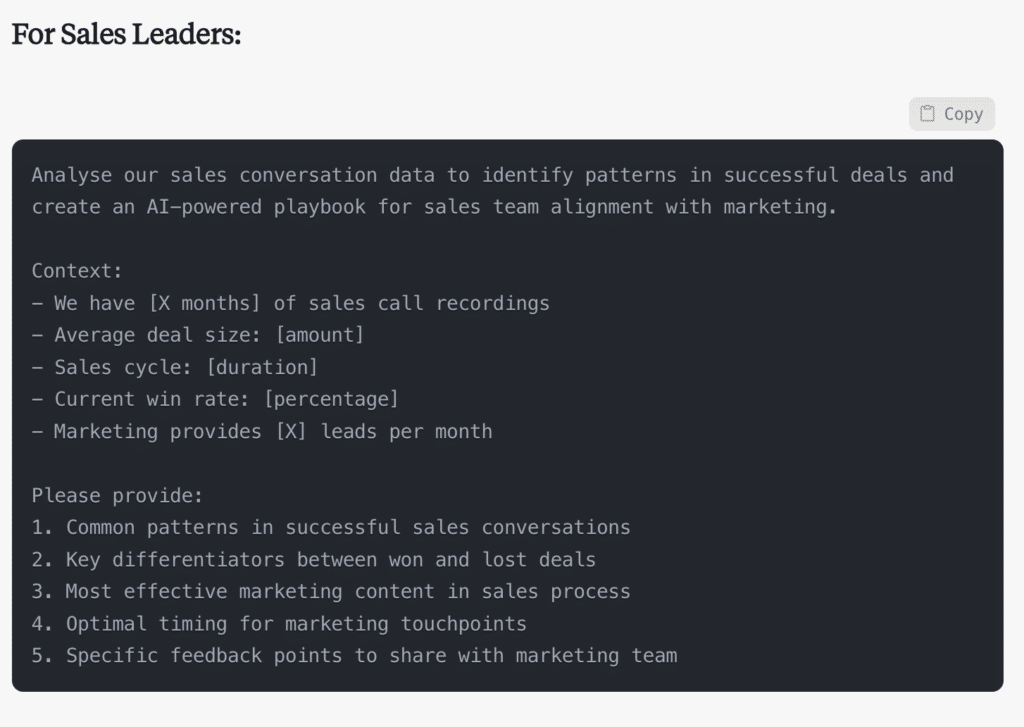
- SEO Strategy, Lead Generation, AI Automation, Marketing Automation, Ai Prompts
Recent articles
our mailing list
B2B Marketing and Sales Alignment: The Key to Performance – Using Ai -November 2024 Update

Two hitchhiking signs tell the entire story of sales and marketing misalignment. One reads “To Jacksonville” – direct, clear, no frills. The other transforms the same journey into “To Mom’s for Christmas” – emotional, contextual, story-driven. Both teams aim for the same destination but speak fundamentally different languages.
This classic challenge plagues growing organisations across Australia. While both teams strive to drive business growth, their approaches, metrics, and priorities often clash. However, the emergence of AI tools has created unprecedented opportunities to bridge this gap and create powerful alignment that drives real business outcomes.

The Current State of Play in Australian B2B
Before we explore the benefits of alignment, it’s crucial to recognize the existing issue of sales and marketing misalignment. Research shows that, on average, the overlap between these two crucial departments is a mere 16%. This lack of synchrony can hinder performance and diminish the efficiency of your B2B marketing sales funnel.
The landscape of B2B business in Australia has shifted dramatically since generative Ai arrived on the scene in November 2022.
Digital transformation has accelerated, customer expectations have evolved, and the line between sales and marketing functions has become increasingly blurred.
Yet, many organisations still struggle with:
- Misaligned metrics and KPIs
- Disconnected customer data
- Competing priorities and resources
- Inefficient lead handoff processes
- Inconsistent messaging across channels.
How AI Changes the Game
Artificial Intelligence isn’t just another buzzword – it’s transforming how sales and marketing teams collaborate. Here’s how:
For Marketing Teams:
- Predictive Lead Scoring
- AI analyses thousands of data points to identify high-value prospects
- Removes subjective bias from lead qualification
- Creates a clear, data-driven handoff process to sales
- Content Personalisation
- Automatically tailors content to specific buyer personas
- Tracks content performance across the sales cycle
- Identifies which materials drive actual conversions
- Customer Journey Mapping
- Creates real-time visibility into prospect interactions
- Identifies optimal timing for sales engagement
- Predicts next best actions for both teams
For Sales Teams:
- Conversation Intelligence
- Analyses sales calls to identify winning patterns
- Provides insights for marketing content creation
- Highlights effective messaging and pain points
- Automated Follow-up
- Ensures consistent engagement without manual effort
- Maintains personalisation at scale
- Tracks and optimises response rates
- Pipeline Analytics
- Predicts deal outcomes with increasing accuracy
- Identifies opportunities for marketing support
- Optimises resource allocation
Practical Implementation Steps
For Marketing Leaders:
- Start with shared dashboards
- Implement AI-powered analytics that both teams trust
- Focus on metrics that matter to both departments
- Create transparent reporting accessible to all stakeholders
- Align content strategy with sales conversations
- Use AI to analyse sales calls and identify content gaps
- Create materials that directly address common objections
- Measure content effectiveness through the entire funnel

For Sales Leaders:
- Share customer insights systematically
- Use AI tools to capture and categorise customer feedback
- Provide regular input on lead quality and scoring
- Contribute to content planning based on customer interactions
- Embrace data-driven decision making
- Use AI predictions for pipeline management
- Share win/loss analysis with marketing
- Implement structured feedback loops

For Business Founders:
- Create unified success metrics
- Define shared KPIs that encourage collaboration
- Implement joint accountability frameworks
- Reward cross-functional wins
- Invest in integrated technology
- Choose AI tools that support both teams
- Ensure systems talk to each other
- Prioritise user adoption and training

How to Use These Prompts:
- Replace bracketed information with your specific data
- Adjust the scope based on your immediate priorities
- Use consistently across your chosen AI platforms
- Iterate based on the responses you receive
- Share results across teams to maintain alignment
Note: These prompts work best with advanced AI tools like ChatGPT-4, Claude, or similar enterprise-grade AI assistants. Adjust the complexity based on your chosen AI platform’s capabilities.

Article by
Simon Gould
CEO / Founder / Dad
Founder and leader, Simon established SDM back in 2012. Since then, he has helped 150 clients (and counting) to achieve their digital goals.[…]



